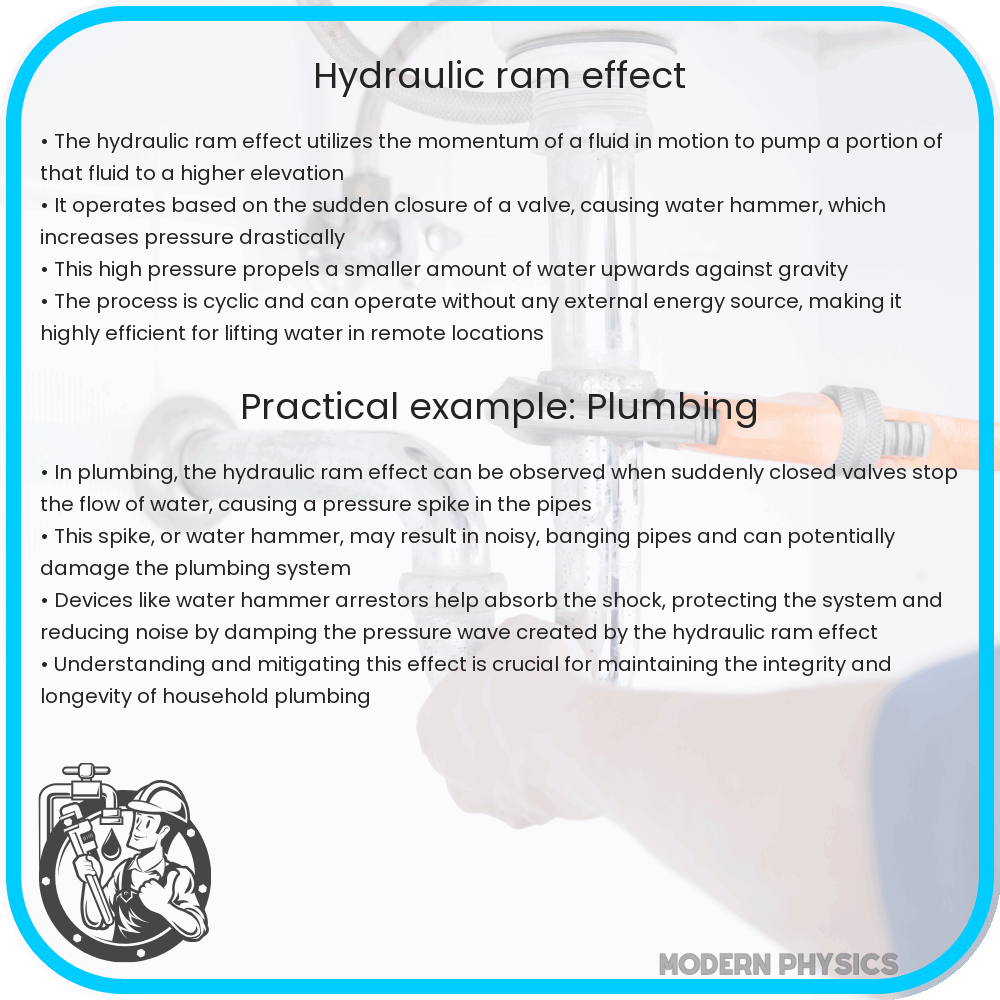Learn about the hydraulic ram effect, a proven fluid mechanics application that uses water’s kinetic energy to pump water to higher elevations without external power.

Introduction to the Hydraulic Ram Effect
Hydraulic rams, or ram pumps, present a fascinating application of fluid mechanics principles in engineering. Essentially, these devices use the energy of a large amount of water falling a small height to lift a small amount of that water to a much greater height. This simple yet effective mechanism has been used since the late 18th century and is particularly useful in areas where other power sources are limited or unavailable.
Understanding the Mechanics of Hydraulic Rams
The operation of a hydraulic ram involves several stages, primarily relying on the principles of pressure and kinetic energy in fluids. The core components of a hydraulic ram include the drive pipe, waste valve, delivery pipe, air chamber, and check valve. Here’s how it works:
- Drive Pipe: Water from a source, such as a pond or a river, flows into the ram through the drive pipe. This flow creates kinetic energy as water moves due to gravity.
- Waste Valve: The flowing water opens this valve, allowing water to exit and reducing pressure within the ram.
- Sudden Closure: Once a certain flow velocity is reached, the waste valve suddenly closes. This action generates a water hammer effect, a high-pressure shock wave due to the momentum of the water.
- Air Chamber: This high pressure forces some water into the air chamber where it compresses the air inside. The compressed air then acts as a spring, storing energy momentarily.
- Delivery Pipe and Check Valve: As the pressure within the air chamber builds, it reaches a point where it exceeds the water source pressure, pushing the water upwards through the check valve and into the delivery pipe, from where it can be directed to storage or used directly.
This cycle repeats itself automatically, maintaining a continuous flow of water without the need for external power sources, utilizing only the hydraulic power of the incoming water.
Efficiency of Hydraulic Rams
The efficiency of hydraulic rams significantly depends on the height from which the water falls (input height) and the height to which it is delivered (output height), alongside the volume of water involved. Typically, the efficiency can be described by the following equation:
E = (Pout / Pin) * 100%
Where Pout is the hydraulic power output and Pin is the hydraulic power input. Because some energy is inevitably lost due to friction and turbulence, hydraulic rams are not 100% efficient. However, they are still highly effective in specific scenarios, typically achieving efficiencies between 30% and 70%.
Uses of Hydraulic Rams
Hydraulic rams are particularly useful in remote or rural areas where electricity or other types of power are too costly or difficult to access. Some of the primary uses include:
- Water Supply: Delivering fresh water to high elevations for agricultural purposes, livestock watering, or rural home water systems.
- Irrigation: Small-scale irrigation where modest amounts of water need to be transferred to higher ground.
- Renewable Energy Projects: Ram pumps can be part of micro-hydro projects, helping to enhance the overall availability of water for power generation.
Due to their simplicity and the minimal maintenance required, hydraulic rams continue to be a sought-after solution in many parts of the world, providing an eco-friendly and cost-effective option for water pumping needs.
Maintenance and Longevity of Hydraulic Rams
Maintenance of hydraulic rams is relatively simple, reinforcing their popularity in areas with limited resources. Regular checks and minor adjustments are required to ensure optimal performance. Common maintenance tasks include:
- Cleaning: Periodic cleaning of the intake and valves to prevent clogging by debris.
- Inspection and Replacement of Valves: The waste and check valves experience frequent mechanical stress and should be inspected regularly for wear and replaced if necessary.
- Air Chamber Check: The air chamber should be checked periodically to ensure that it maintains proper air cushioning for water compression.
With basic maintenance, hydraulic rams can operate efficiently for many years, making them an even more valuable investment in sustainable water management technology.
Future Potential and Technological Integration
The principles of the hydraulic ram pump are well-established, but continuous improvements and technological advancements offer new possibilities. Introducing automation for monitoring and adjustment can help optimize efficiency and reduce maintenance time. Furthermore, integrating these pumps with renewable energy sources, like solar or wind power, could broaden their application in automated and remote farming and water management systems.
Conclusion
Hydraulic rams stand out as a remarkable example of how a simple physics concept — the use of kinetic and potential energy in water — can yield essential real-world applications. From efficiently elevating water without external energy inputs to expanding irrigation capabilities in rugged terrains, hydraulic rams illustrate the enduring power of fluid mechanics. As innovation continues to influence their design and integration into modern water management systems, hydraulic rams hold the potential to play a crucial role in sustainable agriculture and environmental conservation. Their low operational cost, ease of maintenance, and reliability ensure they remain relevant and beneficial across varied contexts globally.
